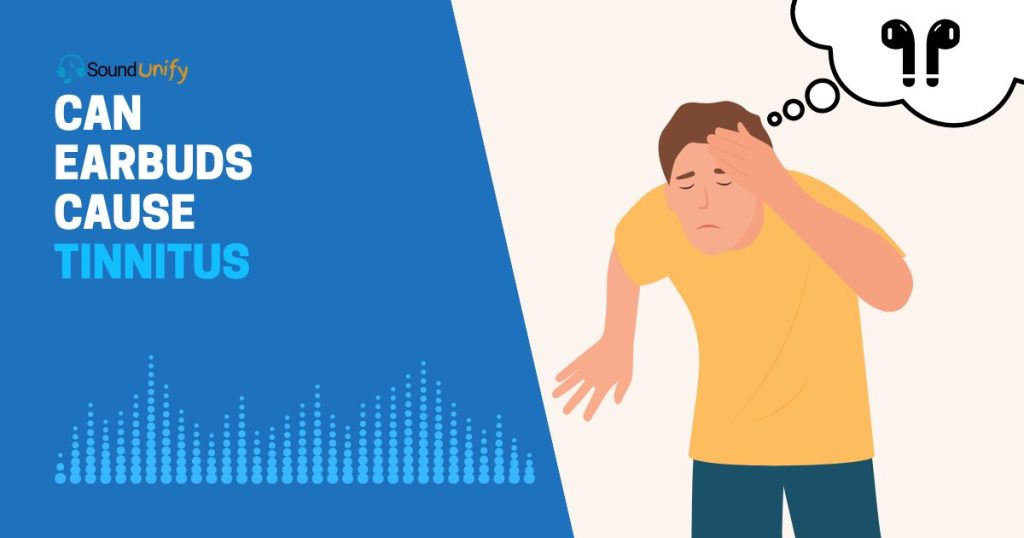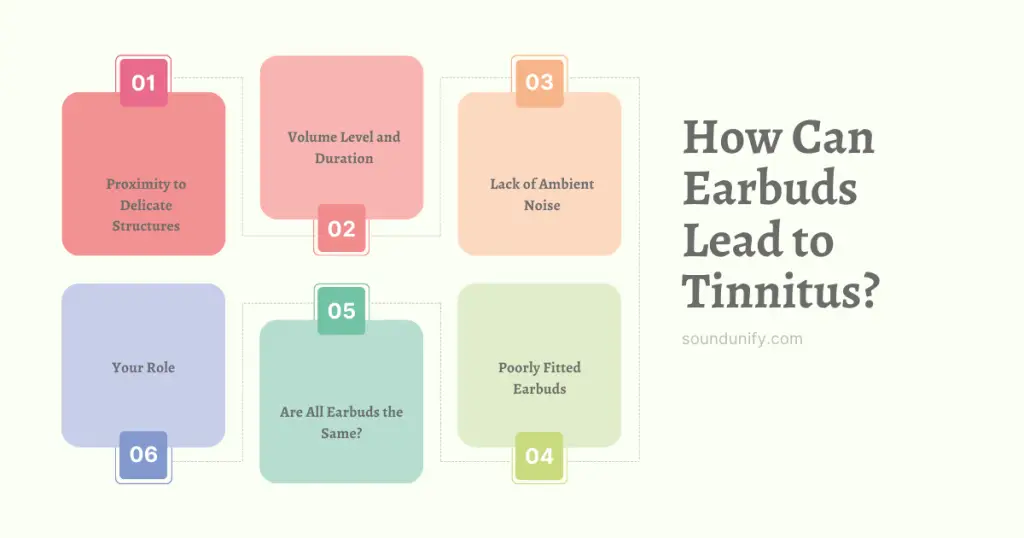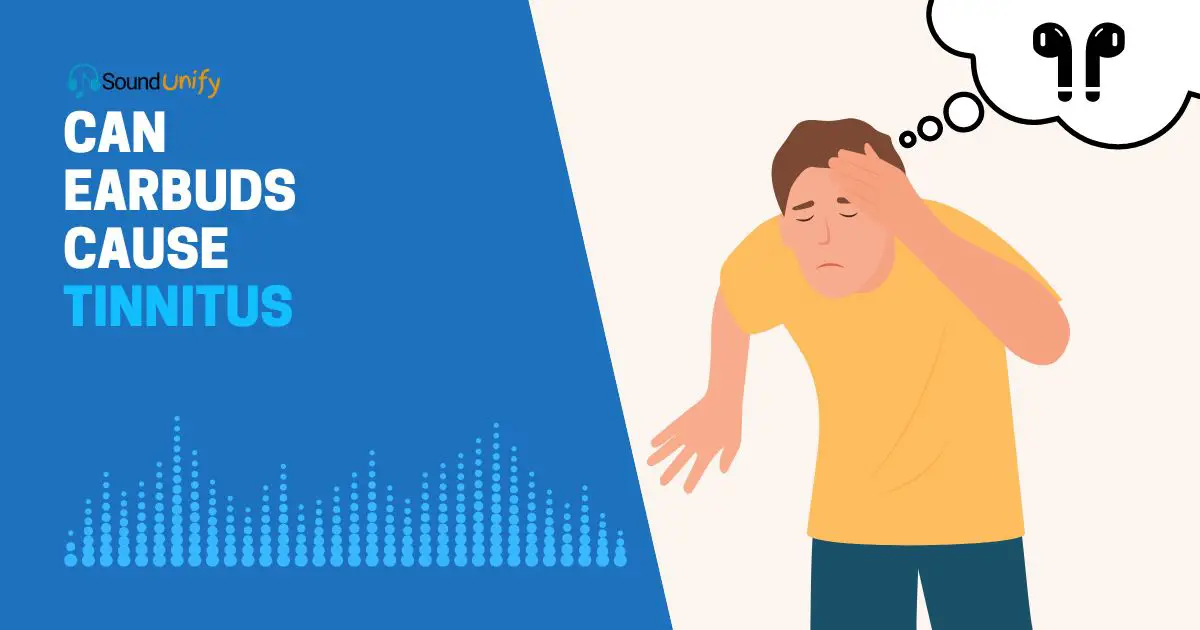Yes, earbuds can cause tinnitus. Prolonged exposure to high volumes is the main culprit.
Now, let me share something personal. I’ve felt that constant ringing in my ears after a long session with my earbuds, and it was unsettling. If you’ve experienced it too, you know what I mean.
Tinnitus isn’t just a minor annoyance; it’s a sign that our ears cry for help. Earbuds, those tiny devices we plug into our ears daily, can be friends and foes. When misused, they can lead to hearing discomfort or, worse, hearing loss. But don’t worry; it’s not all doom and gloom.
Together, we’ll explore the relationship between earbuds and tinnitus, uncovering truths and myths and finding solutions. Trust me, it’s a journey worth taking, especially if you value your hearing as much as I do. Join me, and let’s navigate this path wisely.

What is Tinnitus?
Tinnitus is not merely a sound; it’s a sensation of ringing, buzzing, or hissing when there’s no external noise. I find it akin to an invisible orchestra playing a never-ending tune in your ears. You hear it, but no one else does.
From a scientific perspective, tinnitus is a complex phenomenon. It’s a rebellion by the tiny hair cells in your inner ear. These cells are your ears’ music conductors, guiding the melody of life to your brain.
Damage them, and they start playing their tune. It’s like your ear’s private rock concert, but one you never bought a ticket for.
I’m sure you’re wondering, “What causes this damage?” Exposure to loud noises tops the list. Have you ever stood near a roaring jet engine? Or maybe you’re like me and love blasting your favorite tunes through earbuds.
The noise level matters and it’s not just about volume. Duration plays a role too. An accidental exposure to a loud bang might startle you, but prolonged exposure often leads to tinnitus.
Here’s a table to make it more transparent:
| Causes | What’s Happening in Your Ear |
|---|---|
| Loud noises | Damaging the delicate hair cells in your inner ear |
| Earwax blockage | Like a wrong radio signal, messing with sound transmission |
| Medications | Some can be toxic to inner ear structures |
How Can Earbuds Lead to Tinnitus?

Earbuds have become essential to our daily lives, offering convenience, portability, and direct access to our favorite tunes, podcasts, and more.
However, it’s crucial to recognize that they can also be a path to tinnitus if not used correctly.
Let’s explore this connection between earbuds and tinnitus.
1. Proximity to Delicate Structures
One of the most significant factors linking earbuds to tinnitus is their proximity to delicate structures within the ear. Unlike over-ear headphones, earbuds sit directly inside the ear canal, creating a unique situation.
Here’s how this proximity can lead to problems:
Direct Sound Pathway: Earbuds transmit sound waves directly to the sensitive hair cells within the inner ear. Imagine a high-speed train of noise barreling straight toward these fragile structures. It’s an intense, direct pathway that leaves little room for error.
Increased Volume Risk: Because of this proximity, it’s tempting to crank up the volume to shut out ambient noise. You might not even realize how loud it is. I’ve often found that it’s like talking louder in a noisy room; you don’t notice until the noise stops.
Limited Cushioning: Traditional headphones provide cushioning that can reduce the impact of sound waves. Earbuds, however, often lack this cushioning, creating a situation where the sound has almost no barriers before it hits the inner ear.
Potential for Earwax Build-up: Believe it or not, earbuds can also lead to earwax build-up, which might cause or exacerbate tinnitus. Have you ever noticed earwax on your earbuds? It’s more than just unappealing; it’s a sign of a potential problem.
The intimate relationship between earbuds and your inner ear is like a double-edged sword. On the one hand, this proximity allows for such clear and direct sound transmission.
On the other hand, it’s a risky game where a misstep in volume or usage can lead to lasting consequences like tinnitus. It’s a delicate balance that calls for awareness, responsibility, and proper care for those intricate structures that allow us to hear the symphony of life.
2. Volume Level and Duration
This proximity allows you to drown out background noise without realizing how loud the volume might be.
Have you ever noticed how much louder your earbuds are when you remove them from your ears while the music still plays? I’ve made that mistake, and it’s alarming!
High volume levels can cause irreversible damage to the inner ear’s hair cells responsible for transmitting sound signals to the brain. Coupled with prolonged exposure, it’s a recipe for tinnitus. The louder and longer you listen, the greater the risk.
3. Lack of Ambient Noise
The lack of ambient noise when using earbuds can be both a blessing and a curse. On the one hand, it’s fantastic for immersing yourself in your favorite songs, podcasts, or movies. This lack of background noise can lead to severe hearing-related issues, including tinnitus.
Think of it this way: when you’re in a noisy environment, you naturally raise the volume on your device to hear better. But with earbuds, the ambient noise is often blocked, so you lose a reference point for the loud sound.
It’s like trying to paint a picture with your eyes closed. Without the background noise to guide you, the volume can easily slip into the danger zone without you noticing.
This lack of external sound might encourage you to turn the volume up further than necessary, making the music more intense and possibly damaging the sensitive structures of the inner ear. It’s a subtle trap that can lead to long-term hearing problems if not managed with care and awareness.
4. Poorly Fitted Earbuds
Earbuds come in various shapes and sizes; finding the perfect fit isn’t always easy. Poorly fitted earbuds are more than inconvenient; they can lead to severe issues like tinnitus. Let’s explore why:
- Sound Leakage: If your earbuds don’t fit well, the sound can leak, forcing you to turn up the volume to compensate. Ever notice how you keep reaching for the volume button when your earbuds keep slipping? That’s a risky volume game.
- Irritation and Pressure: Poorly fitted earbuds might exert undue pressure or irritate the ear canal, leading to other problems contributing to tinnitus.
Here’s a table that might help you understand earbuds sizes based on ear size:
| Ear Size | Suggested Earbud Size | Potential Risks If Mismatched |
|---|---|---|
| Small | Extra Small or Small | Sound leakage, discomfort |
| Medium | Medium | Pressure on the ear canal, sound leakage |
| Large | Large or Extra Large | Irritation may not stay in place |
Remember, the right fit is about comfort and protecting your hearing. Like a pair of well-fitted shoes that support your feet, well-fitted earbuds support your hearing health. It's an investment in your well-being that pays off in clear sound and a clear conscience, knowing you're caring for those invaluable ears.
5. Are All Earbuds the Same?
Definitely not! As cars range from basic models to luxury vehicles, earbuds come in various styles, features, and quality levels. Understanding these differences can mean the difference between enjoying your music and risking tinnitus.
Let’s dive into the variations:
- Basic Earbuds: These usually come free with devices and lack features like volume control or noise cancellation. Their focus is on functionality, not necessarily on protecting your ears.
- Volume-Limiting Earbuds: Some earbuds have a feature that limits the volume to a safe level. These can be a godsend if you’re like me and sometimes lose track of the volume.
- Noise-Cancelling Earbuds: These earbuds reduce or cancel out background noise, allowing you to hear clearly without cranking up the volume. They can be like a protective bubble for your ears.
- Custom-Fitted Earbuds: These are tailored to fit your ears perfectly, minimizing sound leakage and ensuring comfort. Think of them as the tailored suit of the earbud world.
Like you wouldn’t wear high heels to hike a mountain, choosing the fitting earbuds for your needs and habits is essential to protect your hearing.
6. Your Role
Your role in protecting your hearing and potentially avoiding tinnitus is paramount. The earbuds don’t control the volume; you do. They don’t decide how long they stay in your ears; you make that call.
Here’s how you can be the hero of your hearing health:
- Volume Control: Keep it at a safe level. A good rule of thumb is the 60/60 rule: no more than 60% of maximum volume for 60 minutes.
- Take Breaks: Give your ears a rest. Like taking a break during a long drive, your ears need time to recover.
- Choose Wisely: Invest in earbuds that suit your ears and listening habits.
- Awareness: Know the signs of potential hearing damage and act accordingly. If something feels off, it probably is.
Can earbuds cause tinnitus? They can, but the connection between earbuds and tinnitus is not a direct sentence to a life of ringing ears. It's a relationship governed by volume, duration, fit, and quality. Just like you wouldn't stare at the sun without proper protection, you shouldn't expose your ears to potential harm without considering their well-being. Ultimately, the power to protect your hearing is in your hands or your ears!
How to Prevent Tinnitus From Using Earbuds?
Tinnitus prevention while using earbuds is a topic close to my heart. Like you, I love losing myself in my favorite tunes. But I also know the risks.
Let’s delve into how you can protect your ears from tinnitus while enjoying your earbuds and make it as engaging as a live concert:
1. Volume: A Balancing Act
Finding the perfect volume while using earbuds is like walking a tightrope. Lean too far one way, and you risk your hearing health. Lean the other way, and you might not enjoy your audio experience.
Here’s how I’ve learned to maintain balance, and you can too:
- Volume Warning Features: Many devices warn you when the volume might be damaging. Trust me, don’t ignore these warnings! Think of them as the rumble strips on the road, guiding you to safety.
- Listening Environment: Be mindful of where you’re listening. In a loud place? Don’t simply turn up the volume. I find noise-cancelling earbuds useful in such situations. They’re like the car windows keeping the traffic noise out.
2. Quality Over Quantity
The quality of your earbuds can be a decisive factor in protecting your hearing. It’s like choosing between a top chef’s gourmet meal and fast food; both fill you up, but one offers a richer experience with healthier ingredients.
Here’s a breakdown:
- Invest in Good Quality Earbuds: I prefer earbuds with features like noise cancellation. It helps me hear clearly without having to turn up the volume. It’s like having high-definition viewing for your ears.
- Select the Right Size: Finding the perfect size is like finding the perfect pair of shoes. It can make all the difference! Here’s a handy table that helped me, and it might help you too:
| Ear Size | Suggested Earbud Size |
|---|---|
| Small | Extra Small or Small |
| Medium | Medium |
| Large | Large or Extra Large |
- Avoid Cheap Knock-offs: I’ve learned that cheap earbuds can often mean poor-quality sound, leading you to increase the volume unnecessarily. It’s like buying a cheap umbrella; it might look good but fails when needed.
3. Fit: The Cinderella Story
Finding the right fit for your earbuds is akin to Cinderella’s quest for the perfect glass slipper. It needs to be just right. Anything less and it can lead to discomfort or even damage. I’ve been there, trying on different sizes, and trust me; the perfect fit is a game-changer.
Here’s what you need to consider:
- Understanding Your Ear Size: Just like you wouldn’t wear shoes that are too small or too big, the same applies to earbuds. I’ve found the following table handy, and perhaps it’ll guide you to your perfect fit too: Ear Size Suggested Earbud Size Small Extra Small or Small Medium Medium Large Large or Extra Large
- Comfort Over Style: Yes, those flashy earbuds might look great, but do they feel great? In my experience, convenience trumps style every time. It’s like choosing a comfortable chair over a stylish but back-breaking one.
- Avoid Pressure and Irritation: Ill-fitting earbuds can cause pressure and irritation. Imagine wearing a tight hat all day long; not pleasant, right?
Finding your perfect fit might take time, but it’s worth the effort. Like Cinderella, your patience and attention to detail will be rewarded. Your ears will thank you, and your audio experience will be magical.
4. Take a Breather
Now, let’s talk about taking breaks. Imagine running a marathon without stopping for water. Sounds extreme, right? The same logic applies to our ears when lost in our favorite music or podcasts.
Here’s how I’ve learned to take a breather and why you should too:
- Follow the 60/60 Rule: I pair my volume control with regular breaks. So, if I’m following the 60/60 rule, I take a break after that hour of listening. It’s like pulling over for gas on a road trip.
- Rest Those Ears: Think of your ears as muscles that need rest after a workout. Give them time to recover, and they’ll perform better in the long run.
- Use Breaks Wisely: I’ve started using my listening breaks as self-care moments. A hot beverage, a stretch, or simply enjoying the sounds of nature can make the experience even more rewarding.
Can Earbuds Help Tinnitus?

No, earbuds generally do not help tinnitus; improper use can exacerbate the condition. However, there’s more to this story that’s worth exploring.
When discussing tinnitus and earbuds, it’s like discussing fire and gasoline. Misusing one can ignite the other. The high volume, continuous use, and potentially poor fit of earbuds can worsen tinnitus. Trust me; I’ve felt the discomfort myself.
However, there’s a twist to this tale. While earbuds may not directly help tinnitus, they can be part of a therapeutic solution when used responsibly. How?
By facilitating sound therapy. Imagine the calming sound of rain, the gentle waves of the ocean, or the soothing notes of soft music. Sound therapy can be an essential tool in managing tinnitus, and earbuds can act as a medium for delivering these therapeutic sounds.
But it’s a delicate dance. Just like you wouldn’t pour gasoline on a controlled fire in a fireplace, you wouldn’t want to misuse earbuds when managing tinnitus. Quality, volume control, and regular breaks are crucial. Consulting a healthcare provider specializing in hearing can guide you in the right direction.
So, while the simple answer is that earbuds don’t help tinnitus, the complete picture reveals a nuanced relationship. The key is understanding the role and using earbuds with awareness and care.
It’s a path that, when walked with caution, can lead to relief and enjoyment rather than discomfort and harm. Isn’t it fascinating how something as simple as earbuds can have a complex relationship with our hearing health? It’s like a puzzle revealing a beautiful picture when carefully put together.
FAQs
Can using earbuds cause tinnitus?
Yes, using earbuds can contribute to the development of tinnitus. Excessive noise exposure, such as listening to music at high volumes through earbuds, can damage the delicate structures in the inner ear and lead to hearing loss and the onset of tinnitus.
Can wearing headphones or earbuds cause hearing loss and tinnitus?
Yes, consistently using headphones or earbuds at high volumes can lead to hearing loss and tinnitus development. Practicing safe listening levels and taking breaks from using headphones to protect your hearing is essential.
Do earbuds cause more hearing loss than headphones?
Earbuds and headphones can both contribute to hearing loss if misused. The risk lies in the volume level and duration of use rather than the specific type of headphones. It is essential to practice safe listening habits regardless of the kind of headphones you use.
Can earplugs cause tinnitus?
Yes, if misused. Earplugs inserted too profoundly or improperly fit can create pressure on the inner ear, potentially leading to tinnitus.
Can earbuds cause pulsatile tinnitus?
While earbuds are not directly linked to causing pulsatile tinnitus, excessive or prolonged use at high volumes can contribute to overall tinnitus, which may exacerbate underlying conditions leading to pulsatile tinnitus.
Can Apple earbuds cause tinnitus?
Yes, like any other earbuds, Apple earbuds can contribute to tinnitus if used irresponsibly, such as listening at high volumes for extended periods or using poorly fitted ear tips.
Final Thoughts
Navigating the earbud-tinnitus maze was enlightening. Earbuds can cause tinnitus, no doubt. But knowledge empowers.
Knowing the risks, we can make wiser choices. Stay safe. Listen responsibly. Cherish every sound. It’s a balance. I learned, adapted, and thrived.
You can too. Sound is precious. Protect it. Stay informed. Happy listening!
James Dimento is a Chief-in-Editor of SoundUnify. He is a headphone enthusiast and creative writer passionate about audio technology. He has three years of experience writing about headphones and sound quality and is responsible for creating reviews and taking care of all administration.
